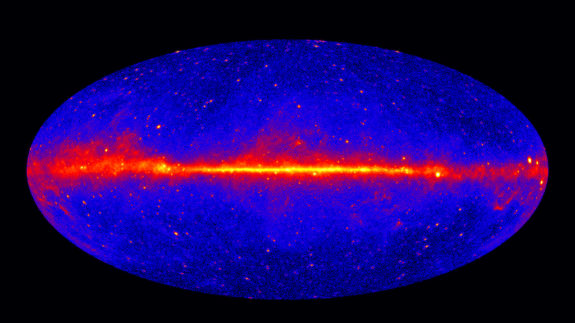On Wednesday, Charlie Bonkowsky attended “The Path To A Next-Generation Gamma-Ray Observatory,” a seminar hosted by Dr. Jeremy Perkins, a NASA astrophysicist.
Do you think we need a new gamma-ray telescope? Dr. Jeremy Perkins of NASA’s Goddard Space Flight Center does.
Currently, there are two larger gamma-ray telescopes in the sky: the Neil Gehrels Swift observatory and the Fermi telescope—and the science they’ve produced has been incredible. The Fermi telescope has been able to compile a gamma-ray map of the sky orders of magnitude better than anything we had before, and is a key component of multi-messenger astronomy: that is, detecting stellar events through several mediums at once. Fermi’s detection of a high-energy gamma-ray burst (GRB) was instrumental in the first gravitational wave detection of two neutron stars colliding with one another, for instance.

But the Swift observatory and the Fermi telescope are 18 and 14 years old, respectively, and there are no plans at the moment for their replacement. There are smaller telescopes in the works—Glowbug, Stardust, Burstcube (which Dr. Perkins himself is the PI for) as well as the small COSI spectroscopy mission—but all with expected lifespans of barely a year or two, and certainly none measuring up to what a true next-generation gamma-ray telescope would look like.
But even in astronomy, history repeats. Back in 1997, the Compton Gamma-Ray Observatory, one of the original Four Great Observatories (along with Hubble, Chandra, and Spitzer), was nearing the end of its lifespan—and NASA had no plans to replace it. A report compiled by dozens of prominent scientists and engineers highlighted this problem; they said, in essence, the discoveries made by gamma-ray astronomy today are incredible, and new work will expand on the litany of questions we still have. However, new work can only continue if NASA makes plans for new gamma-ray telescopes.
This 1997 report was effective:
- They asked for an intermediate energy telescope, which could capture gamma rays with energies ranging from 10 MeV to 100 GeV, which later became the Fermi telescope. Fermi was a true step forward: its two main instruments can see the entirety of the sky, with an unprecedented degree of precision for its time. Even today, it’s still the main gamma-ray telescope, operating without major problems or any degradation in its instruments for 14 years.
- They asked for a focusing hard X-ray telescope, which was ultimately launched in 2012 as the NuSTAR telescope.
- They asked for a Compton telescope to study nuclear line emissions; the COSI telescope, which will do just that, is scheduled to be launched in 2027. COSI promises better energy and angular resolution than any telescope before it, with the ability to see the whole sky in one orbit.
- They asked for an array of smaller telescopes to study the origins of GRBs: Burstcube (Perkins’ project), Glowbug, Stardust, LEAP, and Moonbeam are all slated to launch soon and fill that gap.
- They asked for a low-energy telescope with an ability to see in both the X-ray and UV/optical spectrums, which became the Swift telescope. Matching high-energy bursts to visual imagery has allowed astronomers to see that short GRBs are caused by neutron-star collisions, while longer GRBs are produced by collapsing stars.
What does Dr. Perkins see in this success of the ’97 report? Two things, he said: lead with the science and don’t shy away from the big questions. The ’97 report laid out a long list of difficult questions: the conditions near black holes and neutron stars, the origin of the diffuse gamma-ray background, and the sources of all types of GRBs. Not all of them have been completely answered, but having the questions as a roadmap was what spurred construction and development of the telescopes orbiting today.
Dr. Perkins hopes that success can be replicated. He ended his talk with a call for his scientists and colleagues to talk with NASA, or the ESA, or the NSF, to advocate for funding and a new set of goals. Right now is when the next fifteen or twenty years of gamma-ray astronomy will be decided, and so, he said, we need to push NASA to act.
NuSTAR telescope via NASA/JPL
Fermi Skymap via NASA/DOE/Fermi LAT Collaboration


 0 Comments
0 Comments